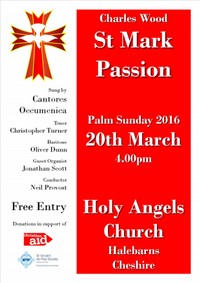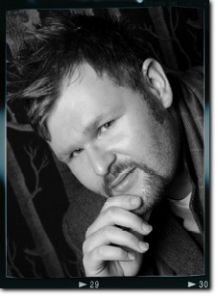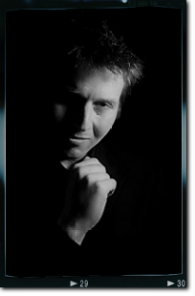St Mark Passion - Charles Wood
Cantores Oecumencia performed Charles Wood's Easter oratorio, St Mark's Passion, on Palm Sunday 2016. You can see the soloists and professional musicians below.
Answering a request from Eric Milner-White, the then Dean of King’s College, Cambridge, Charles Wood completed his setting of the St Mark Passion in August 1920; the work received its first performance on Good Friday 1921, with King’s College Choir directed by A.H. Mann. It is interesting to note that the request came after Mann had reviewed all the available Passion settings, including the two well-known works of J.S. Bach, and concluded that ‘the Bach Passions are too vast for an ordinary choir,  however good’. Milner-White also saw another opportunity, adding that ‘it is about time that the bigger parish churches superseded Stainer’s Crucifixion – or at least had an alternative’.
however good’. Milner-White also saw another opportunity, adding that ‘it is about time that the bigger parish churches superseded Stainer’s Crucifixion – or at least had an alternative’.
 however good’. Milner-White also saw another opportunity, adding that ‘it is about time that the bigger parish churches superseded Stainer’s Crucifixion – or at least had an alternative’.
however good’. Milner-White also saw another opportunity, adding that ‘it is about time that the bigger parish churches superseded Stainer’s Crucifixion – or at least had an alternative’.It is worth looking back a little further to the late nineteenth-century English interest in the Passion narrative. Perhaps stemming from Mendelssohn’s pioneering work and role within the Bach revival, Joseph Barnby established an annual performance of Bach’s St John Passion in London in 1873. Subsequently, numerous composers were moved to set the Passion story within a contemporary libretto rather than one of the Gospel accounts. Following Stainer in 1887, Maunder’s Olivet to Calvary appeared in 1904, and Somervell’s and Nicholson’s Passions were published in 1914 and 1924 respectively. Wood’s setting of 1920 stands out in this collection as the only example of an English setting of the biblical narrative.
In order to break up the biblical narrative into five sections, Wood incorporates four hymns into the scheme. Opening and closing with verses from the plainsong hymn Pange lingua gloriosa, he also uses verses from Verbum supernum prodiens, Lord when we bow before thy throne and My God, I love Thee. Whilst not so well-known to us today, these hymns would have been better-known to the congregation who attended the work’s first performance.
It is the idea of familiarity and intelligibility underlined by the inclusion of well-known hymns and the fact that the story is told in the vernacular, which brings Wood’s scheme into closer consideration with that of J.S. Bach. As with Bach’s inclusion of Lutheran chorales, and the connotations and theological links that they would have suggested to the average Lutheran in the congregation, so here the flow of the biblical narrative in English, interspersed with well-known hymns for choir and congregation, provides the key to the work’s success.
It would be wrong to assume that Wood’s setting is stuck in the Anglican mould of late nineteenth-century romanticism. Whilst it clearly inhabits that sound world, the musical language goes much further than one would expect in comparison to Wood’s numerous setting of canticles and anthems. There are flashes of late Wagnerian harmony alongside the very dry a cappella textures of the fifth gospel. Wood clearly knew J. S. Bach’s many chorale settings for the organ, as the accompaniments to the hymns display his contrapuntal ability akin to J.S. Bach’s Orgelbüchlein settings.
The Soloists and Professional Musicians
Christopher Tuner - Tenor
(click on Christopher's image to see his biography)
Oliver Dunn - Baritone
(click on Oliver's image to see his biography)
Jonathan Scott - Guest Organist
(click on Jonathan's image to see his biography)
Neil Provost - Conductor
(click on Neil's image to see his biography)









